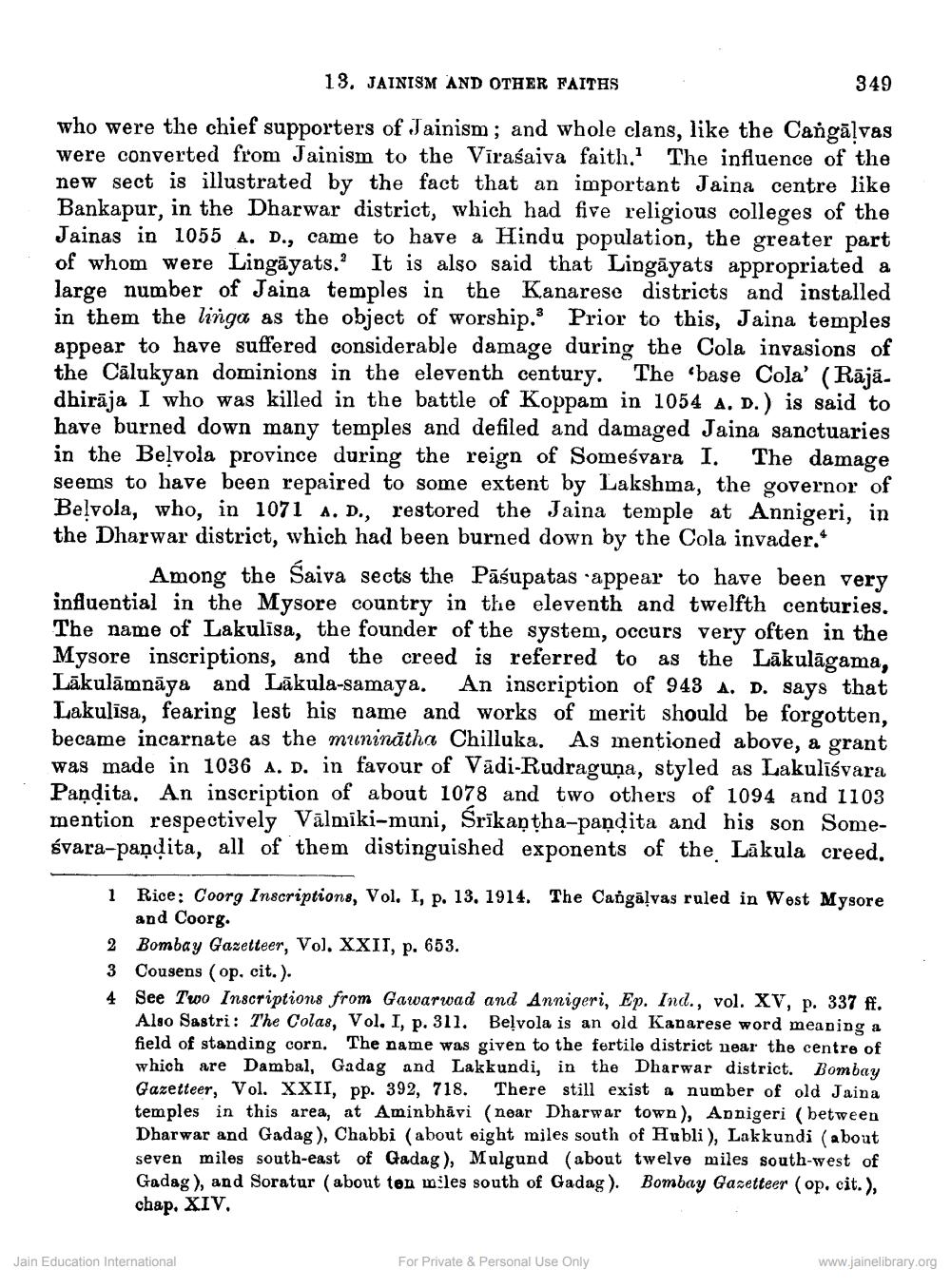________________
13. JAINISM AND OTHER FAITHS
349
who were the chief supporters of Jainism; and whole clans, like the Cangālvas were converted from Jainism to the Viraśaiva faith. The influence of the new sect is illustrated by the fact that an important Jaina centre like Bankapur, in the Dharwar district, which had five religious colleges of the Jainas in 1055 A. D., came to have a Hindu population, the greater part of whom were Lingāyats. It is also said that Lingāyats appropriated a large number of Jaina temples in the Kanarese districts and installed in them the linga as the object of worship. Prior to this, Jaina temples appear to have suffered considerable damage during the Cola invasions of the Cālukyan dominions in the eleventh century. The base Cola' (Rājā. dbirāja I who was killed in the battle of Koppam in 1054 A, D.) is said to have burned down many temples and defiled and damaged Jaina sanctuaries in the Belvola province during the reign of Someśvara I. The damage seems to have been repaired to some extent by Lakshma, the governor of
a, who, in 1071 A. D., restored the Jaina temple at Annigeri, in the Dharwar district, which had been burned down by the Cola
Among the saiva sects the Pāśupatas appear to have been very influential in the Mysore country in the eleventh and twelfth centuries. The name of Lakulisa, the founder of the system, occurs very often in the Mysore inscriptions, and the creed is referred to as the Lākulāgama, Lākulāmnāya and Lākula-samaya. An inscription of 943 A. D. says that Lakulisa, fearing lest his name and works of merit should be forgotten, became incarnate as the muninātha Chilluka. As mentioned above, a grant was made in 1036 A. D. in favour of Vadi-Rudraguna, styled as Lakulisvara Pandita. An inscription of about 1078 and two others of 1094 and 1103 mention respectively Vālmiki-muni, Srikantha-pandita and his son Someśvara-paņdita, all of them distinguished exponents of the Lākula creed.
1 Rice: Coorg Inscriptions, Vol. I, p. 13. 1914. The Cangāļvas ruled in West Mysore
and Coorg. 2 Bombay Gazetteer, Vol. XXII, p. 653. 3 Cousens (op. cit.). 4. See Two Inscriptions from Gawarwad and Annigeri, Ep. Ind., vol. XV, p. 337 ff.
Also Sastri: The Colas, Vol. I, p. 311. Belvola is an old Kanarese word meaning a field of standing corn. The name was given to the fertile district near the centre of which are Dambal, Gadag and Lakkundi, in the Dharwar district. Bombay Gazetteer, Vol. XXII, pp. 392, 718. There still exist a number of old Jaina temples in this area, at Aminbhāvi (near Dharwar town), Apnigeri (between Dharwar and Gadag), Chabbi (about eight miles south of Hubli), Lakkundi (about seven miles south-east of Gadag), Mulgund (about twelve miles south-west of Gadag), and Soratur (about ten miles south of Gadag). Bombay Gazetteer (op. cit.), chap. XIV.
Jain Education International
For Private & Personal Use Only
www.jainelibrary.org




